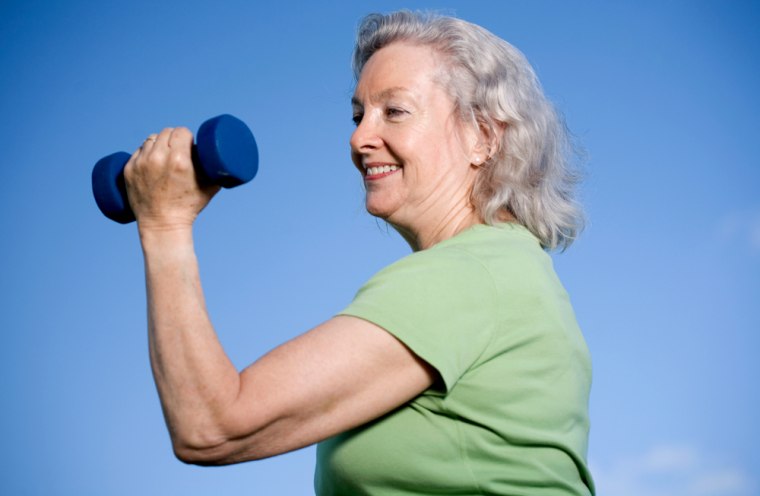What can you do to firm up flabby arms and slim down fat feet? How do you know if you’re injured — or just really sore? Smart Fitness answers your workout queries.
Have an exercise question? To e-mail us, click here. We’ll post select answers in future columns.
Q: How can I shape up my unsightly batwing arms?
A: The flab that’s hanging from your upper arms is likely the combined result of excess body fat and poor muscle tone, says Diane Vives, a personal trainer in Austin, Texas, and spokesperson for the National Strength and Conditioning Association.
So to make those bat wings fly away, your fitness regimen should focus on both cardiovascular exercise and strength-training.
While you can’t exercise to lose weight in just your arms, cardio will help you burn fat all over — including the arms. How much cardio you need for weight loss is highly dependent on how much food you eat, so take a hard look at your diet, advises Vives.
“You can work out one to two hours a day, sleep eight hours, and 14 hours put junk in the body – it’s just not going to help,” she says.
To lose a pound of fat, you need to create a deficit of 3,500 calories through diet and exercise. How much exercise? The new physical activity guidelines from the federal government note that many people wanting to lose significant amounts of weight will need to get more than 300 minutes of moderate physical activity a week. Vives believes that most people wanting to lose weight will need 45 to 60 minutes a day of activity, ideally vigorous activity (if you’re sedentary, though, start slowly and build up).
As for strength-training, you’ll need to shape up both your triceps and biceps, says Vives. Push-ups are a good exercise that target both and can be done either on the ground or against a wall or countertop (for beginners), she notes. Other exercises she recommends adding to the mix include standing cable presses, biceps curls and the overhead shoulder press. Aim to strength-train two or three days a week, says Vives, and with each exercise do two to three sets of 12 to 15 repetitions.
Q: What exercise is recommended for fat ankles and feet?
A: The same exercise that’s recommended for fat arms, fat thighs and fat bellies: fat-burning cardio.
If you’ve got fat feet, we’re assuming you’re overweight pretty much all over (if that’s not the case, or your feet are actually swollen rather than fat, be sure to consult your doctor).
So just as you can’t spot reduce your backside, for instance, you can’t spot reduce your feet either, says Vives. You need an overall weight-loss plan that includes a healthful diet and aerobic activity.
Q: How do I know if I'm just sore or really injured? I have been exercising six days a week for three months now. I've lost 40 pounds so far. However, lately, I am experiencing EXTREME pain in my quads. At one point, about two weeks ago, I trained with a trainer who had me do several squats with weights. I've done squats before, but not to this extreme. I was in a lot of pain afterward but figured it was because it was a tough workout. I seemed to have healed until recently, when I did a normal amount of squats and am experiencing that same extreme pain I did weeks ago — but from a fraction of the workout. I've tried soaking, moist heat pads, muscle-relaxers, anti-inflammatories, yet I can't seem to make it better. It's now hindering my workouts — please help!
A: It’s not unusual to feel a little sore after a strength workout, particularly if you’re trying a new activity or one you haven’t done in awhile, but it’s not normal to feel “extreme” pain, says Dr. Christopher D. Harner, medical director of the Center for Sports Medicine at the University of Pittsburgh Medical Center and a spokesperson for the American Academy of Orthopaedic Surgeons.
So get yourself to a sports-medicine specialist for an evaluation. It’s possible you could have a stress fracture, severe muscle strain or another problem, says Harner.
“Red flags for any active person to remember are both the duration and degree of pain, anywhere in the body,” he says. When pain persists for more than a week and does not go away, even when resting, consult a doctor to find out why.
